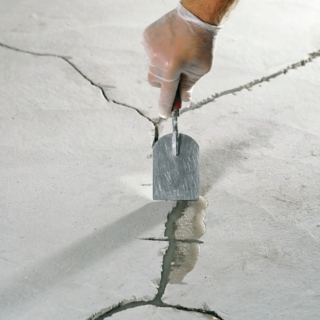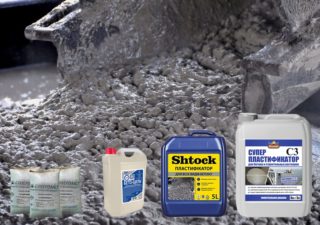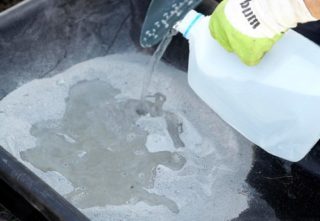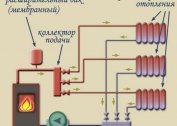The arrangement of the warm floor takes place in several stages. One of them is pouring screeds. The use of conventional solutions does not provide the necessary strength and mobility, therefore, add special substances - plasticizers. They make the screed more resistant to thermal deformation and allow it to maintain its integrity.
Purpose and properties of plasticizer
Concrete substrates are considered strong and reliable, however, in practice, the construction of the classic concrete mixture has its own properties that adversely affect the screed. Therefore, it becomes necessary to add a plasticizer to the screed.
When creating a concrete mix for screed it is difficult to achieve uniformity of composition. During mixing air bubbles form, some particles of concrete remain in pieces. As a result, the solution itself will have an uneven density, and an excess of liquid will not allow you to create a uniform mixture. All this will negatively affect the technical and physical properties.
The consequences that a standard approach to pouring a concrete layer without a plasticizer will lead to:
- Uneven surface heating in different areas of the warm floor.
- Thermal expansion of the screed caused by excess moisture. As a result, deformations, cracks and chips will form on the floor surface.
- The appearance of cavities in the concrete layer. Negatively affect the parameters of thermal conductivity.
Cracks in the screed of the electric underfloor heating are not allowed. Because of them, the cable will overheat and as a result may become unusable. Cracks can be prevented by adding plasticizer. This substance is added in the process of creating a solution of cement, sand and water. When it enters the mixture, the plasticizer reacts with the particles of cement and creates a strong adhesion. As a result, the screed becomes more durable, ductile and resistant to compression and stretching.
The plasticizer for screed floor heating consists of various chemical elements that, when in contact with water, begin to thin the solution. Refined phenols, formalin, and sulfuric acid concentrate are used.
As a result of the addition of a plasticizer, the ratio of water to cement does not change. In this case, the solubility of the resulting mixture increases. The concrete pouring process is simplified due to plasticity and the complete filling of the space with a solution.
Advantages and disadvantages
The main positive qualities of a plasticizer include:
- The formation of a structure with increased density. Thanks to this, the heating elements are reliably protected.
- Uniform heat distribution over the entire surface of the warm floor.
- Reducing the thickness of the concrete screed by increasing the density.
- Decrease in internal pressure in a concrete layer due to plasticity.
- The use of leveling compounds is not required. The surface after hardening becomes perfectly smooth.
- When adding a plasticizer, the screed dries faster.
- Environmental friendliness of modern materials and the absence of corrosion on the metal parts of the floor.
- Safety for health.
The main disadvantage is the positivity of initial solidification. But it allows you to fix errors that were made during the pouring. To reduce the initial hardening time, additional solidification catalysts are used.In general, the pour time is shorter than when pouring a classic concrete screed.
Selection and Application Criteria
There are two forms of release of plasticizer:
- Liquid. The composition must be mixed with water and dry cement in a certain ratio. The numbers can be found on the packaging of the mixture.
- Dry. The principle of use is similar, but the initial stage is different. The dry mixture must be mixed with water in a ratio of 1: 2 and let the resulting solution infuse.
Small volumes can be mixed using a mixer. When the batch is finished, it is necessary that the solution is infused. Next, a secondary lag is carried out and filling begins.
When working with plasticizer, you must adhere to the recommendations that the manufacturer indicates on the package. Work should be carried out in warm time at temperatures not lower than + 5 ° C.
The choice of material also depends on the type of floor. Not every additive is suitable for use with underfloor heating; there must be an appropriate mark on the package. Another important criterion is price. It consists of the characteristics and consumption of the material. Per unit area accounts for 0.5-1 l of finished high-quality mixture. Cheaper additives increase consumption several times.
Top manufacturers
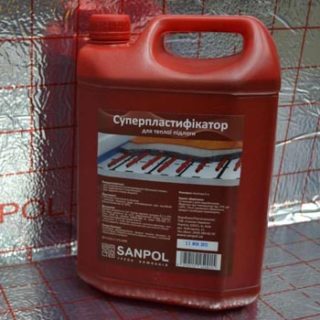
The most common are Sanpol, ArmMix, Rehau and S-3. Other brands are also engaged in manufacturing.
The Ukrainian company Sanpol produces a plasticizer in the form of a liquid mixture, which positively affects the thermophysical properties of the screed. The advantages of the products of this company include the initial setting time. If errors are detected during pouring, they can be quickly corrected. The ratio of modifier to cement is 0.2 L: 400 kg.
ArmMix is produced by the Russian company Thermoplast. The properties are the same as those of Sanpol, but the ratio is different. Used 1 liter of plasticizer per 100 kg of cement. You can work with the solution at low temperatures.
Superplasticizer С-З is a liquid consistency that is used with high-grade concrete. This allows you to improve the strength characteristics and reduce cement consumption. The ratio of modifier and cement is 1.5-2 l: 100 kg.
Rehau is a premium product. Allows you to create thin and medium layers of concrete for floor heating.
Which composition is better to choose depends on the characteristics of the floor, the room, the requirements for screed and the financial component. Buying cheap mixtures is not profitable. In practice, they will require a larger number than when using high-quality additives at a higher price.
Instruction for use
The range of additives is wide, each has its own properties and mixing proportions. Detailed information on the ratio is indicated by the manufacturer in the instructions. The plasticizer is well compatible with crushed stone and sand, cement, Portland cement.
Creating a mixture you need to start with the selection of the necessary materials and ingredients. A minimum capacity of 10 liters will be required, in which the product will be whipped using a construction mixer. Further according to the instructions, the remaining components are added. In case of insufficient addition of plasticizer, the solidification process will occur faster. The dry additive is diluted in warm water with the calculation of 200 g per 1 liter, after which it is left to stand for 1-2 hours.
Do it yourself
You can create a plasticizer for a warm floor with your own hands. The process is simple, the cooking time is short.
To improve viscosity, you will need shampoo, liquid soap, or a stylish powder (previously dissolved in water).
The algorithm for creating the mixture:
- Mix cement, sand and water until a homogeneous solution.
- Add liquid soap or powder to 200 ml of water. Thanks to these ingredients, the initial solidification time will be reduced, and the likelihood of cracking will fall by 4 times.
- Add the mixture to the solution and mix again with a construction mixer.
To further reduce the risk of cracking, you can add 30 grams of hydrated lime per 50 kg of solution.
Homemade plasticizer will be inferior in quality to purchased deliveries. Soap contains substances that can adversely affect concrete over time.
Concrete constructions, including screed for underfloor heating, have high demands on quality and reliability. They can be provided by the addition of various substances that improve the viscosity of the solution. Plasticizer for a heat-insulated floor also belongs to such structures.

